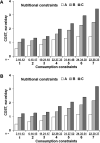Are the lowest-cost healthful food plans culturally and socially acceptable?
- PMID: 20105388
- PMCID: PMC4103898
- DOI: 10.1017/S1368980009993028
Are the lowest-cost healthful food plans culturally and socially acceptable?
Abstract
Objective: Nutritious yet inexpensive foods do exist. However, many such foods are rejected by the low-income consumer. Is it because their use violates unspoken social norms? The present study was designed to assess the variety and cost of the lowest-cost market basket of foods that simultaneously met required dietary standards and progressively stricter consumption constraints.
Design: A mathematical optimisation model was used to develop the lowest-cost food plans to meet three levels of nutritional requirements and seven levels of consumption constraints.
Subjects: The nationally representative INCA (National Individual Survey of Food Consumption) dietary survey study of 1332 adults provided population estimates of food consumption patterns in France. Food plan costs were based on retail food prices.
Results: The lowest-cost food plans that provided 9204 kJ/d (2200 kcal/d) for men and 7531 kJ/d (1800 kcal/d) for women and met specified dietary standards could be obtained for <1.50 euro/d. The progressive imposition of consumption constraints designed to create more mainstream French diets sharply increased food plan costs, without improving nutritional value.
Conclusions: Minimising diet costs, while meeting nutrition standards only, led to food plans that provided little variety and deviated substantially from social norms. Aligning the food plan with mainstream consumption led to higher costs. Food plans designed for low-income groups need to be socially acceptable as well as affordable and nutritious.
Figures

References
-
- Smith A. The Wealth of Nations. Book. 1776
-
- Darmon N, Drewnowski A. Does social class predict diet quality? Am J Clin Nutr. 2008;87:1107–1117. - PubMed
-
- Mackenbach JP, Stirbu I, Roskam AJ, Schaap MM, Menvielle G, Leinsalu M, Kunst AE. Socioeconomic inequalities in health in 22 European countries. N Engl J Med. 2008;358:2468–2481. - PubMed
-
- Drewnowski A, Specter SE. Poverty and obesity: the role of energy density and energy costs. Am J Clin Nutr. 2004;79:6–16. - PubMed
-
- Maillot M, Darmon N, Darmon M, Lafay L, Drewnowski A. Nutrient-Dense Food Groups Have High Energy Costs: An Econometric Approach to Nutrient Profiling. J Nutr. 2007;137:1815–1820. - PubMed
Publication types
MeSH terms
Grants and funding
LinkOut - more resources
Full Text Sources
Miscellaneous

